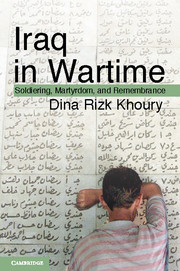Book contents
- Frontmatter
- Contents
- List of Illustrations, Maps, and Table
- Acknowledgments
- Note on Translations and Transliteration
- Maps
- 1 Introduction
- 2 Iraq’s Wars under the Ba‘th
- 3 The Internal Front
- 4 Battlefronts
- 5 Things Fall Apart
- 6 War’s Citizens, War’s Families
- 7 Memory for the Future
- 8 Commemorating the Dead
- 9 Postscript
- Appendix I Distribution in Percentage of Ba‘th Party Members, “Friends of Saddam,” and Martyrs in Fifteen Iraqi Provinces, 1998–1999
- Appendix II Percentage of Ba‘th Party Membership among Matriculating Students (Sixth Secondary) in Ten Iraqi Provinces, 1987–1988
- Appendix III Report Issued by Ali Hasan al-Majid, Head of the Northern Bureau of the Ba‘th Party to the General Secretariat, August 1987
- Sources and Bibliography
- Index
- References
4 - Battlefronts
War and Insurgency
Published online by Cambridge University Press: 05 March 2013
- Frontmatter
- Contents
- List of Illustrations, Maps, and Table
- Acknowledgments
- Note on Translations and Transliteration
- Maps
- 1 Introduction
- 2 Iraq’s Wars under the Ba‘th
- 3 The Internal Front
- 4 Battlefronts
- 5 Things Fall Apart
- 6 War’s Citizens, War’s Families
- 7 Memory for the Future
- 8 Commemorating the Dead
- 9 Postscript
- Appendix I Distribution in Percentage of Ba‘th Party Members, “Friends of Saddam,” and Martyrs in Fifteen Iraqi Provinces, 1998–1999
- Appendix II Percentage of Ba‘th Party Membership among Matriculating Students (Sixth Secondary) in Ten Iraqi Provinces, 1987–1988
- Appendix III Report Issued by Ali Hasan al-Majid, Head of the Northern Bureau of the Ba‘th Party to the General Secretariat, August 1987
- Sources and Bibliography
- Index
- References
Summary
The propaganda machine of the Iraqi government painted the war as an extension of a Ba‘thist revolution that fused the leader, nation-state, and party in a violent but necessary defense of the nation. Fighting at the front forged a sense of national unity that could override social and communal divisions. The Ba‘thist state had fashioned what its ideologues defined as an “ideological army,” one penetrated by Ba‘thist army officers and overseen by Ba‘thist commissars committed to the state and the party’s vision of the nation. In reality, the military leadership and the Ba‘th Party premised the conduct of war on policies that had less to do with forging national unity and more to do with security. The regime’s security and the maintenance of the state’s territorial sovereignty became the driving force of the war after 1982, when Iranian troops began making headway into Iraqi territory, drawing on the support of Kurdish and other opposition parties in the north and in the southern marshes. Thus, the regime was waging two kinds of war at the same time: a war of national security and a war of counterinsurgency.
The line between the two kinds of war was quite fluid, as evidenced by the regime’s handling of two of the war’s most important components – the management of men on the front and the management of territory. The first concerned the mobilization, training, loyalty, and retention of men as fatalities and desertion increased and as the insurgent north and the southern marshes became a magnet for those fleeing the front. To manage these two issues, the regime followed a two-pronged strategy. First, it invested resources and expanded the reach of the Ba‘th Party propaganda on the front. Second, it developed a system of distinctions to reward and punish performance on the front, monitor dissent, and ensure outward ideological conformity.
- Type
- Chapter
- Information
- Iraq in WartimeSoldiering, Martyrdom, and Remembrance, pp. 82 - 122Publisher: Cambridge University PressPrint publication year: 2013

